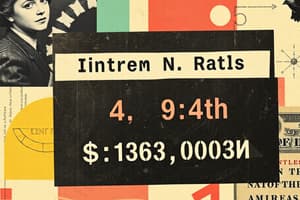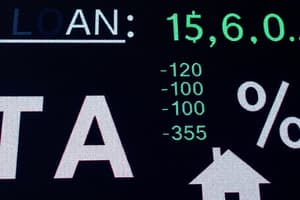Podcast
Questions and Answers
What effect does an increase in expected inflation have on the supply curve for bonds?
What effect does an increase in expected inflation have on the supply curve for bonds?
- It shifts the supply curve to the left.
- It shifts the supply curve to the right. (correct)
- It causes the supply curve to become vertical.
- It has no effect on the supply curve.
Which factor is negatively related to the quantity demanded of an asset?
Which factor is negatively related to the quantity demanded of an asset?
- Expected return
- Liquidity
- Wealth
- Risk (correct)
Which statement accurately describes a characteristic of US Treasury bonds?
Which statement accurately describes a characteristic of US Treasury bonds?
- They are susceptible to income tax considerations.
- They are considered default free. (correct)
- They have high liquidity but high default risk.
- Their interest rates are always lower than municipal bonds.
What happens to the quantity supplied of bonds as prices increase?
What happens to the quantity supplied of bonds as prices increase?
What does the yield curve represent?
What does the yield curve represent?
How does an increase in government budget deficits affect the supply of bonds?
How does an increase in government budget deficits affect the supply of bonds?
Which type of bond interest payments are exempt from federal income taxes?
Which type of bond interest payments are exempt from federal income taxes?
What primarily determines heterogeneity across the yields of bonds with the same maturity?
What primarily determines heterogeneity across the yields of bonds with the same maturity?
What does the present value of a future cash flow consider?
What does the present value of a future cash flow consider?
How is yield to maturity (YTM) defined?
How is yield to maturity (YTM) defined?
When the price of a coupon bond is below its face value, how does the yield to maturity compare to the coupon rate?
When the price of a coupon bond is below its face value, how does the yield to maturity compare to the coupon rate?
What is a characteristic of a consol or perpetuity?
What is a characteristic of a consol or perpetuity?
For a discount bond, how is the yield to maturity calculated?
For a discount bond, how is the yield to maturity calculated?
What does the equation $i_c = \frac{C}{P_c}$ represent for a consol bond?
What does the equation $i_c = \frac{C}{P_c}$ represent for a consol bond?
What is the characteristic of a fixed payment loan?
What is the characteristic of a fixed payment loan?
Which calculation defines the rate of return?
Which calculation defines the rate of return?
Flashcards
Present Value
Present Value
The value of a future cash flow expressed in today's dollars. A dollar today is worth more than a dollar tomorrow due to the potential for earning interest.
Yield to Maturity (YTM)
Yield to Maturity (YTM)
The interest rate that equates the present value of future cash flows from a debt instrument to its current market value.
Consol or Perpetuity
Consol or Perpetuity
A bond that pays a fixed coupon payment forever and does not have a maturity date.
Discount Bond
Discount Bond
Signup and view all the flashcards
Coupon Rate
Coupon Rate
Signup and view all the flashcards
Current Yield
Current Yield
Signup and view all the flashcards
Coupon Payment
Coupon Payment
Signup and view all the flashcards
Face Value (Par Value)
Face Value (Par Value)
Signup and view all the flashcards
Inverse Relationship between Bond Prices and Interest Rates
Inverse Relationship between Bond Prices and Interest Rates
Signup and view all the flashcards
Bond Demand
Bond Demand
Signup and view all the flashcards
Bond Supply
Bond Supply
Signup and view all the flashcards
Default Risk
Default Risk
Signup and view all the flashcards
Bond Liquidity
Bond Liquidity
Signup and view all the flashcards
Term Structure of Interest Rates
Term Structure of Interest Rates
Signup and view all the flashcards
Factors Affecting Bond Yields
Factors Affecting Bond Yields
Signup and view all the flashcards
Yield Curve
Yield Curve
Signup and view all the flashcards
Study Notes
Measuring Interest Rates
- Present value: a dollar received today is worth more than a dollar received in the future
- Simple present value: PV = CF / (1 + i), where PV is present value, CF is future cash flow, and i is the interest rate. This is useful for comparing payments at different points in time.
Simple Loan
- The value of an initial amount borrowed is related to future cash flows by the interest rate over the appropriate period
- Future cash flow equals the initial amount borrowed plus interest
- For simple loans, the yield to maturity equals the simple interest rate.
Fixed Payment Loan
- Fixed cash flows paid every period throughout the life of the loan.
- Loan value (LV) is equal to the sum of the future fixed payments (FP) discounted to the present value (using the yield to maturity or YTM) over the maturity period.
- Formula for calculated Loan Value (LV): LV = FP / (1 +i) + FP/ (1+i)^2 + ... + FP/(1+i)^n
Coupon Bond
- Pricing: present value of future coupon payments + face value at maturity
- The price and yield to maturity are negatively related (higher yields, lower prices).
- Yield to maturity is greater than the coupon rate if the bond price is below face value.
Discount Bond
- Price of the bond is less than the face value.
- The yield to maturity (YTM) is calculated by the difference between the face value and current price, divided by the initial price.
Market Instruments
- Simple loan: a loan with a single payment at maturity
- Fixed payment loan: equal payments made over the life of the loan.
- Coupon bond: periodic interest payments (coupons) and a final payment at maturity (face value)
- Discount bond: purchased at a discount from the face value, paying face value at maturity; no periodic interest payments.
Yield to Maturity (YTM)
- The interest rate that equates the present value of all cash flows (coupons and principal repayment) from a bond to its current market price.
Consol or Perpetuity
- A bond with no maturity date that pays fixed coupon payments forever.
- Price equals the coupon payment divided by the yield to maturity
Rate of Return
- The total return on an investment expressed as a percentage of the initial investment. This is also known as the realized rate of return, or an ex post rate of return.
Supply and Demand in the Bond Market
- At lower prices (higher interest rates), the quantity demanded of bonds is higher (negative relationship)
- At lower prices (higher interest rates), the quantity supplied of bonds is lower (positive relationship)
What Shifts Bond Demand?
- Higher wealth, higher expected return (relative to other assets), lower risk of return (relative to other assets), and higher liquidity relative to other assets.
What Shifts Bond Supply?
- Profitability of investments, inflation expectations, and government budget influence supply.
Determining Heterogeneity in Bond Yields
- Default risk: the probability that a bond issuer won't make interest payments or pay back face value.
- Liquidity: the ease with which a bond can be converted to cash.
- Income taxes: tax considerations relating to interest payments.
Term Structure of Interest Rates
- Yield curve: a plot of yields on bonds with different terms to maturity.
- Upward-sloping: long-term rates are higher than short-term rates.
- Flat: short- and long-term rates are the same.
- Inverted: long-term rates are lower than short-term rates.
Theories to Explain Yield Curve Facts
- Expectations theory
- Segmented markets
- Liquidity premium theory
Expectations Theory
- Long-term interest rates are an average of expected future short-term interest rates.
Segmented Markets Theory
- Bond investors prefer bonds of specific maturities and these preferences determine the yields of different maturity bonds ( independent to the expectations of future short-term rates)
Liquidity Premium Theory
- Long-term interest rates equal an average of expected future short-term interest rates plus a liquidity premium that reflects investors' preference for bonds with shorter maturities.
Studying That Suits You
Use AI to generate personalized quizzes and flashcards to suit your learning preferences.




